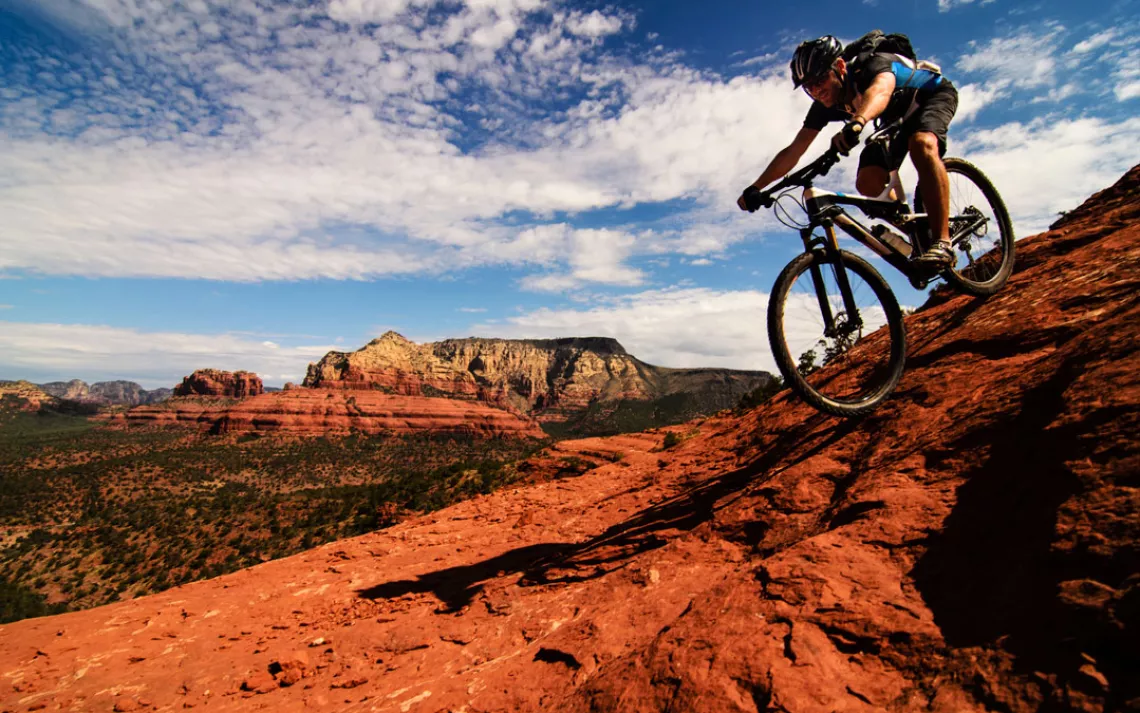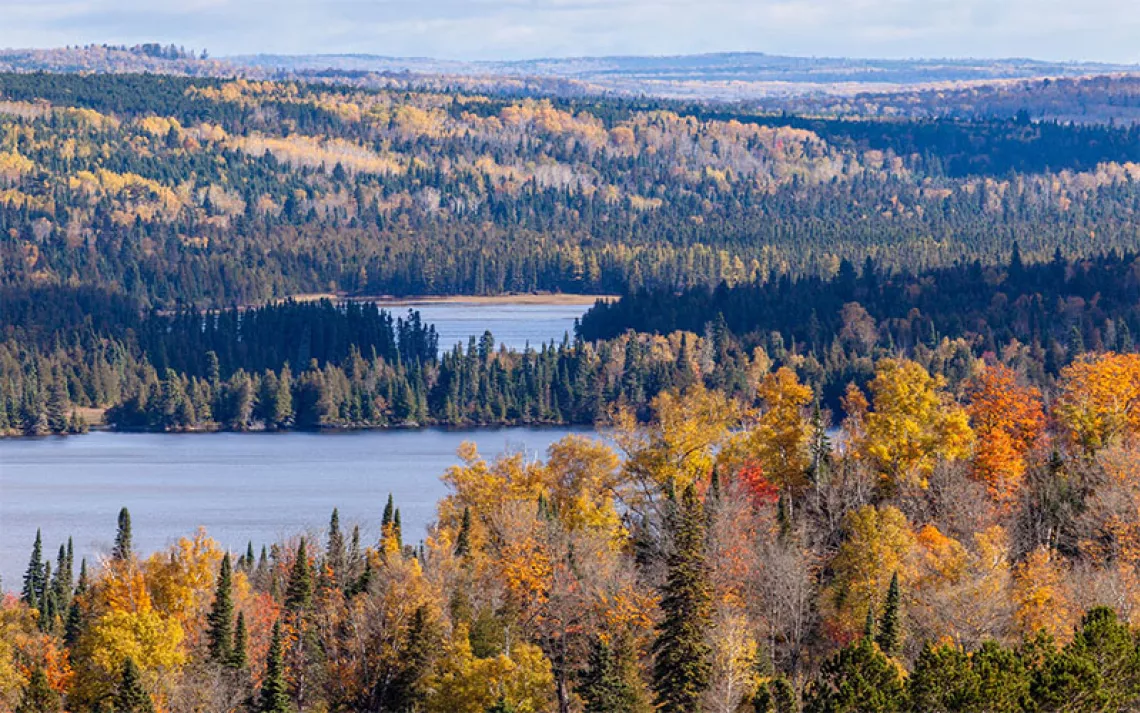Funhogs and Treehuggers, Together at Last
An effort is underway to form a stronger conservation movement from the disparate strands of the outdoor recreation community

Mountain biking on slickrock | Photo by ikick/iStock
Two times a year, once in the winter and once in the summer, movers and shakers in the outdoor recreation industry gather in Salt Lake City for the Outdoor Retailer trade show. It is the place to be for companies that make gear, clothing, and footwear for outdoor adventure. All of the big brands are present—Patagonia, The North Face, Arc'teryx—as well as smaller ones like bootmaker Lowa and trekking pole manufacturer Leki, in addition to major retailers from Amazon to REI. There’s feverish schmoozing, a ton of great schwag, plus lots of awesome keg parties featuring Utah’s signature three-two beer.
But for a long time—too long, in fact—Outdoor Retailer hasn’t been all that important a venue for the individuals and organizations engaged in the political efforts to conserve wild places. “When I first started coming here, 10 or 12 years ago, I felt like I was the only conservationist in the hall,” Dan Ritzman, the Sierra Club’s longtime Alaska program director and a veteran environmental organizer, told me when I bumped into him near the kayak and canoe section at last August’s show. Ritzman had just come from a meeting—with Christy Goldfuss, head of the White House Council on Environmental Quality, and outdoor gear leaders like Peter Metcalf, cofounder of Black Diamond—at which possible national monument designations were discussed. The meeting had left Ritzman hopeful that perhaps two parallel universes are beginning to cross. “Now, I feel like things are changing.”
Ritzman’s observation about the historic absence of conservation activists at Outdoor Retailer hints at a tension that has long lurked beneath the surface of the broader outdoor enthusiast community—that is, the gap between the funhogs and the treehuggers.
This divide is probably as old as that classic patina photograph of President Teddy Roosevelt and John Muir above Yosemite Valley. Roosevelt, of course, would be the archetypal funhog—a person who goes into the wild on the hunt (literally or figuratively) for the thrills of adventure. Muir represents the archetypal treehugger—someone who enters the wild searching for inspiration or mystical revelation. For the funhogs, wild spaces are like a gym without a roof; for the treehuggers, the wilderness is more like a church with fresh air. If the funhog wants to conquer the peak, the treehugger is often content with simply contemplating it.[1]
The misalignment in interests can, at times, lead to misunderstandings and unhelpful judgments. To the treehugger, the funhogs seem like mere adrenaline junkies. To the funhog, the treehuggers can come across as self-righteous scolds. The funhogs might be moving too fast to notice the birds and the flowers, but then the treehuggers are probably so out of it that they’ve never even heard of Strava.

Backpackers in the mountains | Photo by Paolo Cipriani/iStock
In the last couple of decades, this divide may have deepened as many places, especially in the Mountain West, have become ever more crowded with people. Trails that were once quiet are now packed with scores of people on every sunny weekend. The trail runners, mountain bikers, climbers, birdwatchers, slack-liners, and hikers jostle each other for space and a measure of the solitude they came looking for in the first place. At times, seemingly sympathetic activities can become incompatible with each other.
“There is sometimes this sense out there of, ‘If you’re not engaging with nature in the way that I am, then it’s wrong.’ It’s kind of like, ‘You kids and your rock-and-roll music.'” says climber Christian Beckwith. “But, look, we’re in the midst of the sixth mass extinction. If we’re saying, ‘Your way of being in nature is worse and I won’t work with you,’ then we all lose.”
Beckwith is now spearheading an effort to bridge the gap between the funhogs and the treehuggers. He’s got the rock-solid outdoorsman cred to do so. Raised on a farm in Maine, he spent his childhood hunting and fishing, and as a young man developed a passion for climbing. In 2001, he founded the mountaineering magazine Alpinist. His latest endeavor is something called the SHIFT Conference, a three-day gathering designed to thread together the sometimes disparate strands of outdoor enthusiasts by recognizing the various tribes share a lot of common ground—namely, trying to protect from industrial development as much land and water as possible.
“What I’m trying to do is pull together the people who are working on similar outcomes, but separately,” Beckwith says.
The conference program proves the point. Treehugger Terry Tempest Williams is giving the opening speech. Modern hunter-gatherer Steven Rinella will headline the main banquet. Wyoming’s Republican governor, Matt Meade, will be there, as will Colorado’s Democratic governor, John Hickenlooper. The Sierra Club’s own Stacy Bare—a former National Geographic Explorer, climber, and backcountry skier who straddles the funhog-treehugger gap with his 6'4" frame—is another speaker. (Full disclosure: Sierra is a media sponsor of this year’s gathering.)
“I’m just very interested in trying to get my part of the outdoor recreation spectrum to embrace the protection of those places that we profess to love so much,” Beckwith says.
A couple of trends are driving Beckwith’s sense of urgency. One is the new aggressiveness of the public lands transfer movement (or, if you prefer, the public lands heist movement). While the melodramatic actions of the Bundy clan have gotten the most attention, state legislatures across the West have sought to push for the transfer of public lands from the federal government to the states, a move that would jeopardize the integrity of many national forests and BLM lands. The second—hardly news to anyone in the outdoor recreation or conservation communities—is the fact that the ranks of outdoor enthusiasts are disproportionately old and white. “You’re not going to be able to protect these places if it’s just a bunch of older Caucasians, which a lot of the time it is,” Beckwith says.
While the funhog-treehugger divide is real, there’s a danger in exaggerating it. To the city slicker who never leaves the confines of asphalt and concrete, the funhogs and treehuggers probably all look like the same polar-fleece-cloaked flock. Disagreements over, say, the appropriateness of selfie sticks in the woods can seem like little more than the narcissism of small difference, to borrow a line from Freud. And of course there are some inspiring examples of funhog-treehugger hybrids—Patagonia founder, climber, angler, and political activist Yvon Chouinard being the best example.
“I think that, in some instances—mountain bikes and wilderness areas being one of them—there is a bit of a divide there, mostly having to do with the various laws we have to protect lands,” says John Sterling, executive director of the Conservation Alliance, a coalition of outdoor gear companies that funds land protection efforts, and itself embodies that Yvon Chouinard ethic. “But I think that divide is so overstated. . . . If there is a divide between the recreationalists and the conservationists, then rubbing shoulders is a great way to overcome some of that—and, a lot of the time, they are the same people.”
And even when they aren’t exactly the same people, there are some shared values. For starters, a love of the sufferfest—whether that means sitting in a blind for hours upon hours waiting for game to show up, humping up a mountain with a pack, or climbing from one fingerhold to the next. Beyond that, there is the common commitment to Leave No Trace principles—to keeping wild places as one finds them.
Beckwith and Sterling agree that what the broader outdoor enthusiast community needs now is what we might call LNT 2.0. That is, a collective ethic that calls, not just for leaving a place intact, but to in some way give back to that place—whether that means through on-the-ground ecosystem restoration projects or by engaging in the political efforts to defend public lands once one has left the trail or the climbing route. It doesn’t matter whether people go into wild places to play or to pray; either way, they are motivated by a passion for place. And that bond should prove stronger than any superficial divides.
“The common ground is we all love these places,” Sterling says. “This is about a bridge, not a divide. The bridge is the mountain, the trail, the landscape that everyone cares about.”
[1] In all fairness, it’s important to point out that such categories are rarely ironclad. Muir, after all, was a fearless, if not foolhardy, mountaineer with many first ascents to his name. And, in some ways, Roosevelt was a superior naturalist in comparison with Muir.
 The Magazine of The Sierra Club
The Magazine of The Sierra Club






